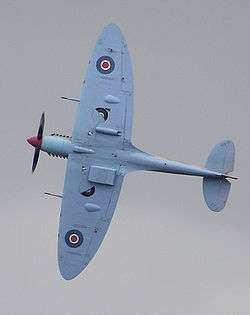Elliptical wing

An elliptical wing is a wing planform whose leading and trailing edges each approximate two segments of an ellipse.
Not to be confused with annular wings, which may be elliptically shaped
Properties
Theoretically, the most efficient way to create lift is to generate it in an elliptical spanwise distribution across the wing.[1] However, an elliptical planform by itself does not produce an elliptical distribution of lift across the span of a wing. There is no inherent superiority to pure elliptical shapes, and wings with other planforms can be optimized to give elliptical spanwise lift distributions.
The basic elliptical wing shape also has disadvantages:
- The almost uniform lift distribution of a constant-aerofoil section elliptical wing can cause the entire span of the wing to stall simultaneously, potentially causing loss of control with little warning. To improve the stalling characteristics and give the pilot some warning, designers use a non-uniform aerofoil. For example, the wing of the Supermarine Spitfire was both thinned towards the tips and twisted to give washout, reducing the load on the tips so that the inner wing would stall first.[2][3] Such compromises depart from the theoretical elliptical lift distribution, increasing induced drag. Thus, in practice the elliptical planform seldom achieves the theoretical efficiency of an elliptical lift distribution.
- Elliptical wing planforms are more difficult to manufacture.[4] In it, either leading edge or trailing edge or both are curved, and the ribs change in a non uniform way along the wingspan. In practice, most elliptical wings are approximations, for example several sections of the Spitfire leading and trailing edges are arcs of circles.
The semi-elliptical wing
For a wing to have an elliptical area distribution, it is not necessary for both the leading and trailing edges to have an elliptical shape. If one of these is straight, as in the semi-elliptical planform, the wing will still have an elliptical area distribution.
Several aircraft of this type have been produced, one of the most successful being the American Seversky P-35.
History
Few aircraft have used the elliptical wing, and even fewer have seen mass production, most in the 1950s and 60s. It was first used in the 1920s, [see Bäumer B II "Sausewind" of 1925]. The Supermarine S.4 racing seaplane flew in 1925. It failed to win its race but its designer, Reginald Mitchell, would later return to a near-elliptical planform for the Supermarine Spitfire, which first flew in 1936. The German Heinkel He 70 "Blitz" of the early 1930s was a fast mail plane and reconnaissance bomber, and the predecessor to the Heinkel He 111 bomber, early models of which used an elliptical wing. Almost all of the United States Republic P-47 Thunderbolts used elliptical wings, except the last models, which had squared-off wingtips. The Imperial Japanese Navy used an elliptical wing very similar to that of the He 70 on their Aichi D3A dive bomber, and the external wing outline of the excellent 1930s era Mitsubishi A5M carrier fighter was almost identical to that of the Spitfire, in spite of being brought into service well before the Spitfire was. Several other types had planforms which differed relatively little from the elliptical.
The British Aircraft company Swift Aircraft are currently developing a two-seater Very Light Aircraft, Light-sport aircraft and CS-23 category Aircraft, the Swift Aircraft Swift, featuring elliptical wings.
References
- L. J. Clancy (1975), Aerodynamics, Pitman Publishing Limited, London ISBN 0-273-01120-0
- McCormick, Barnes W. (1979), Aerodynamics, Aeronautics, and Flight Mechanics, pp 135–139, John Wiley & Sons, New York, ISBN 0-471-03032-5
- Milne-Thomson, L.M. (1966, 1973), Theoretical Aerodynamics, 4th Ed., Dover Publications Inc, New York. ISBN 0-486-61980-X. pp 208–209
Notes
- ↑ Clancy (1975) sections 5.17, 5.25 and 8.14
- ↑ "Spitfire"", Aeroplane icons No. 14, Kelsey, 2013, Page33.
- ↑ 'Smith, J.; "The development of the Spitfire and Seafire", Journal of the Royal Aeronautical Society, 1947, Pages 343.
- ↑ Knauff, Thomas (2012-10-24). The Glider Flying Handbook. BookBaby. ISBN 978-1-62488-139-8.